How to clean decking efficiently, with or without a pressure washer
Follow our expert step-by-step guide for cleaning wooden decking, ready to enjoy this summer
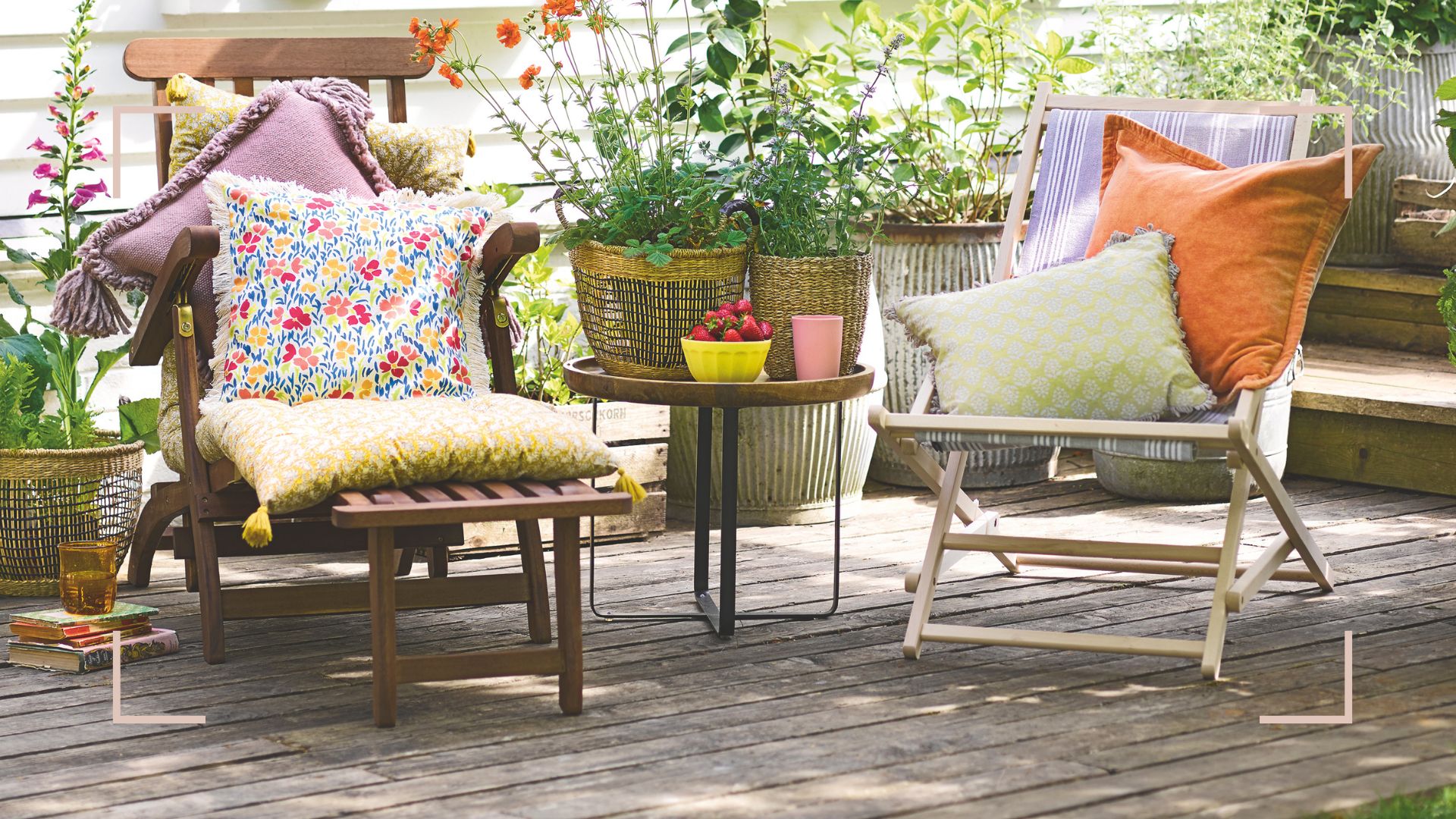
Emily Smith
Now is the perfect time to get outside and give your wooden decking a good clean. After a winter of UK weather, your poor decking has certainly seen better days so why not follow this guide to get it looking brand new again?
While it might seem like a daunting task, thankfully, cleaning decking is a relatively simple chore, like cleaning patio slabs, especially with a little help from our experts.
This guide will explain how to clean your deck and keep it looking clean and fresh. Our expert will explain how to clean wooden decking properly, with or without a pressure washer, to ensure you cover all bases and don't damage your garden decking.
How to clean decking without a pressure washer
There’s nothing worse than deciding to host a BBQ only to realise you’ve forgotten to clean the BBQ and the decking is still covered in slippery moss. So, before you start positioning your best outdoor furniture in prep, it's important to clean your decking beforehand to ensure your outdoor space is in tip-top condition.
It's important to know how to clean your wooden decking properly, so we've spoken to experts to find out how it should be done. And whilst your decking isn't one of the things you should never pressure wash in your garden, there are some precautions when it comes to using one.
"Pressure washing decking can be a double-edged sword," says Leo Watts, an engineer and contributor at CNCSourced. "While it's efficient in cleaning, it can also cause damage if not done correctly. I've seen cases where pressure washing led to splintering and gouging of the wood. So, it's essential to be cautious and use a low-pressure setting, keeping a safe distance from the surface."
You also need to check the weather before getting started on cleaning your wooden decking. "You not only want to make sure that your decking is dry, but that it’s unlikely to rain in the next 24 hours," Roxil's garden expert Jonathan Kirby advises.
Sign up to our free daily email for the latest royal and entertainment news, interesting opinion, expert advice on styling and beauty trends, and no-nonsense guides to the health and wellness questions you want answered.
Here's what you will need to begin cleaning...
- Stiff-bristled brush broom
- Garden hose
- Either a specialist deck cleaning solution or oxygen bleach
- Protective gloves
- Soft-bristled brush
- Paint roller (optional)
- Decking stain or sealer (optional)
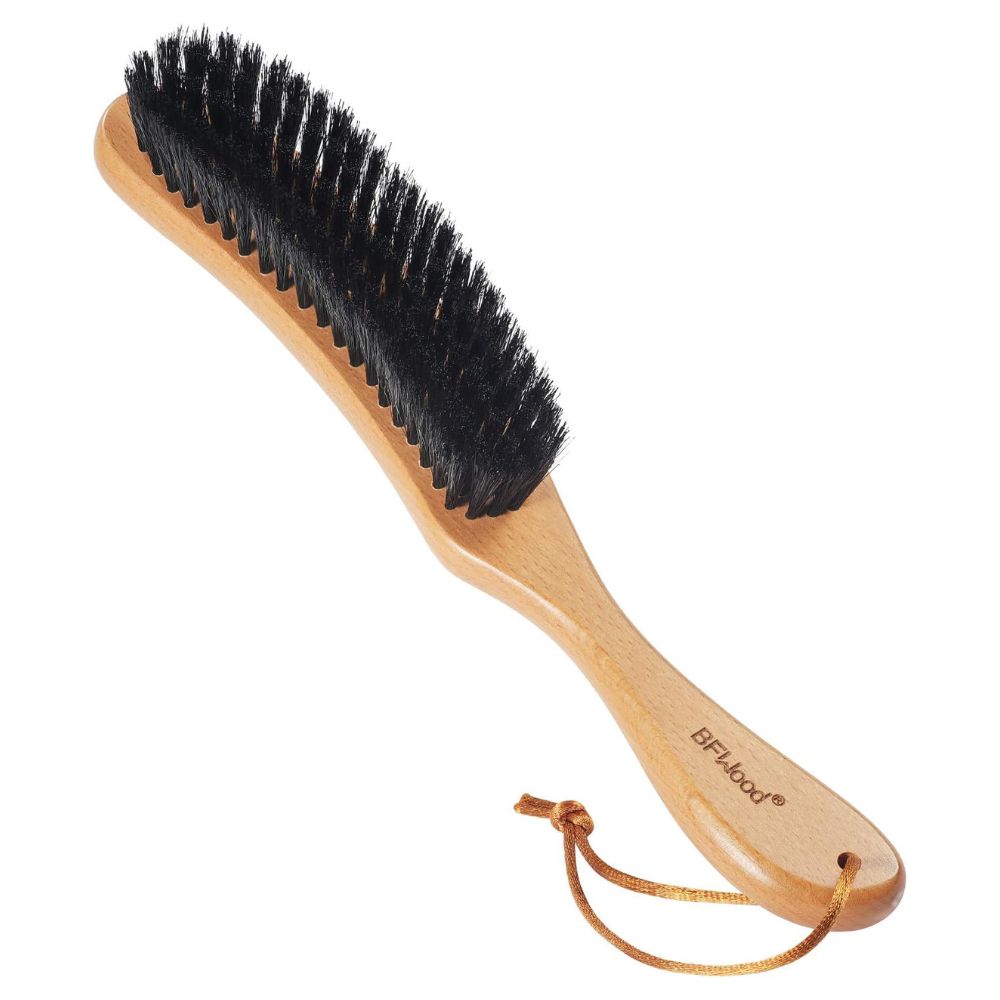
RRP: £13.98 | This boar bristle brush is the perfect tool for cleaning your decking, with the soft bristles it will effectively dislodge any dirt and dust without damaging the clay exterior.

RRP: £9.99 | This high-quality brush will make quick work of various garden tasks including cleaning your decking. With a support bracket and thick wooden handle, sweeping will feel that much easier

RRP: £13.30 | If you've got some stubborn stains, this bleach can work wonders. It can make quick work of greening decking and even stained clothes when used in the wash. It comes highly recommended by customers, too.
1. Clear the area
Similar to how you would declutter your home prior to cleaning a room, before you can get stuck into cleaning your decking, you need to make sure that all your furniture and any loose items are removed to ensure a clear and safe workspace.
Any objects on your porch are just going to get in your way. Make sure your porch or deck area is empty of any objects that will block you from cleaning. This may seem like an obvious step, but many people try to just clean around objects. Not only does this leave dirt under the objects, but they just prove frustrating when you try to clean the deck later.
"Begin by removing all furniture, plants, and other items from your decking," advises Ivo Iv, founder of Decor Home Ideas. "This will ensure you have full access to the entire surface and prevent any damage to your belongings."
2. Sweep away the debris and check the crevices
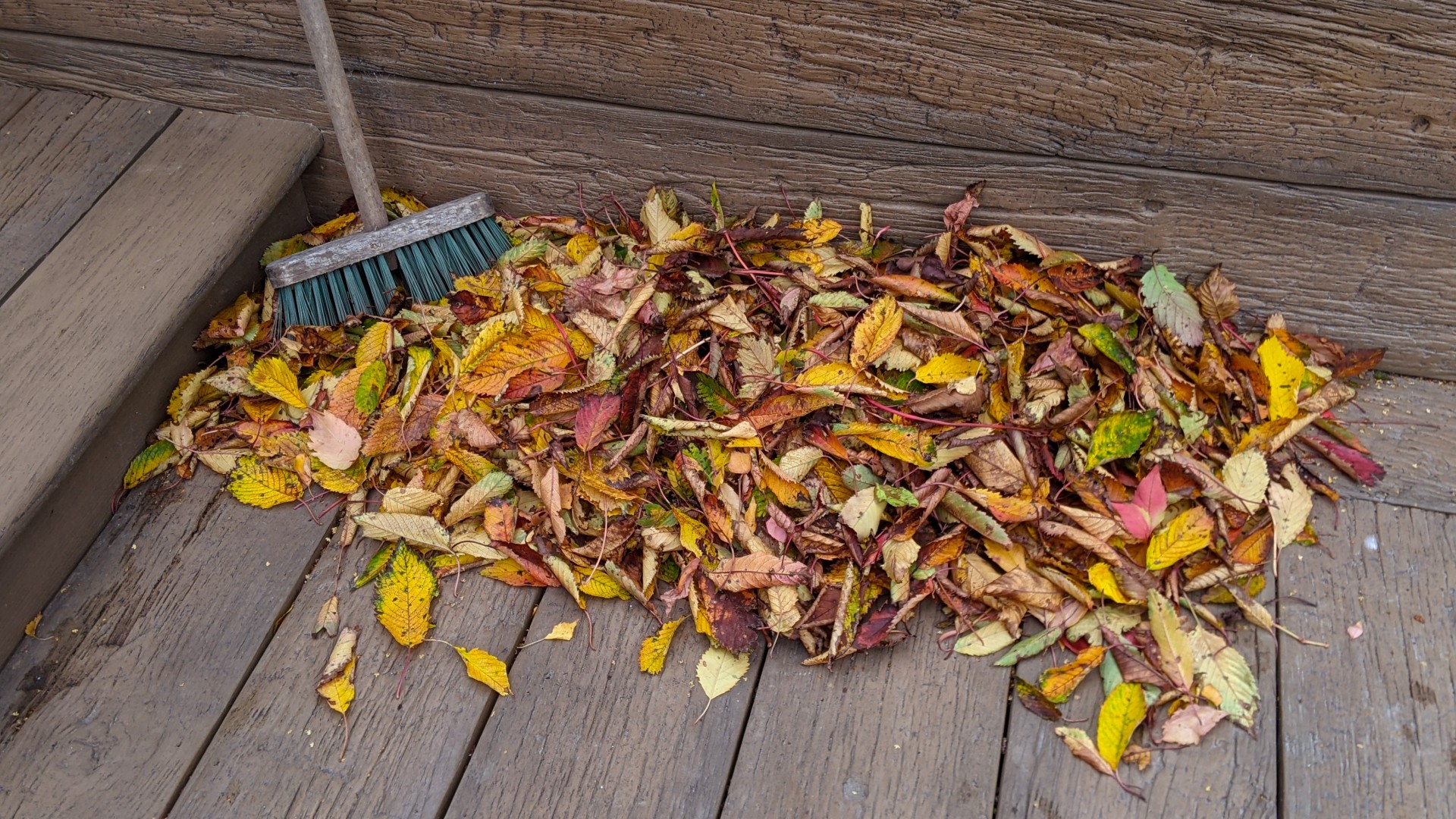
Next, you'll need to grab your broom and start sweeping. Sweep down your deck to ensure that you get all the debris off that's built up over the winter months, especially in areas with many trees, because branches and leaves tend to accumulate quickly. A quick clean will get rid of most of the big pieces.
Now is also the time to take an object like a smaller soft-bristled brush and clear the space between the crevices. This is a place where material can gather and begin to rot your boards, and it's better to be safe than sorry. Cleaning at this level is a great way of making your garden look more expensive on a budget, the details are what matter after all.
This step ensures your wooden decking is completely clear of loose dirt before adding any wet cleaning solutions, to avoid potential staining and prevent any buildup of algae. The same principles apply when cleaning terracotta pots.
3. Choose your cleaning solution
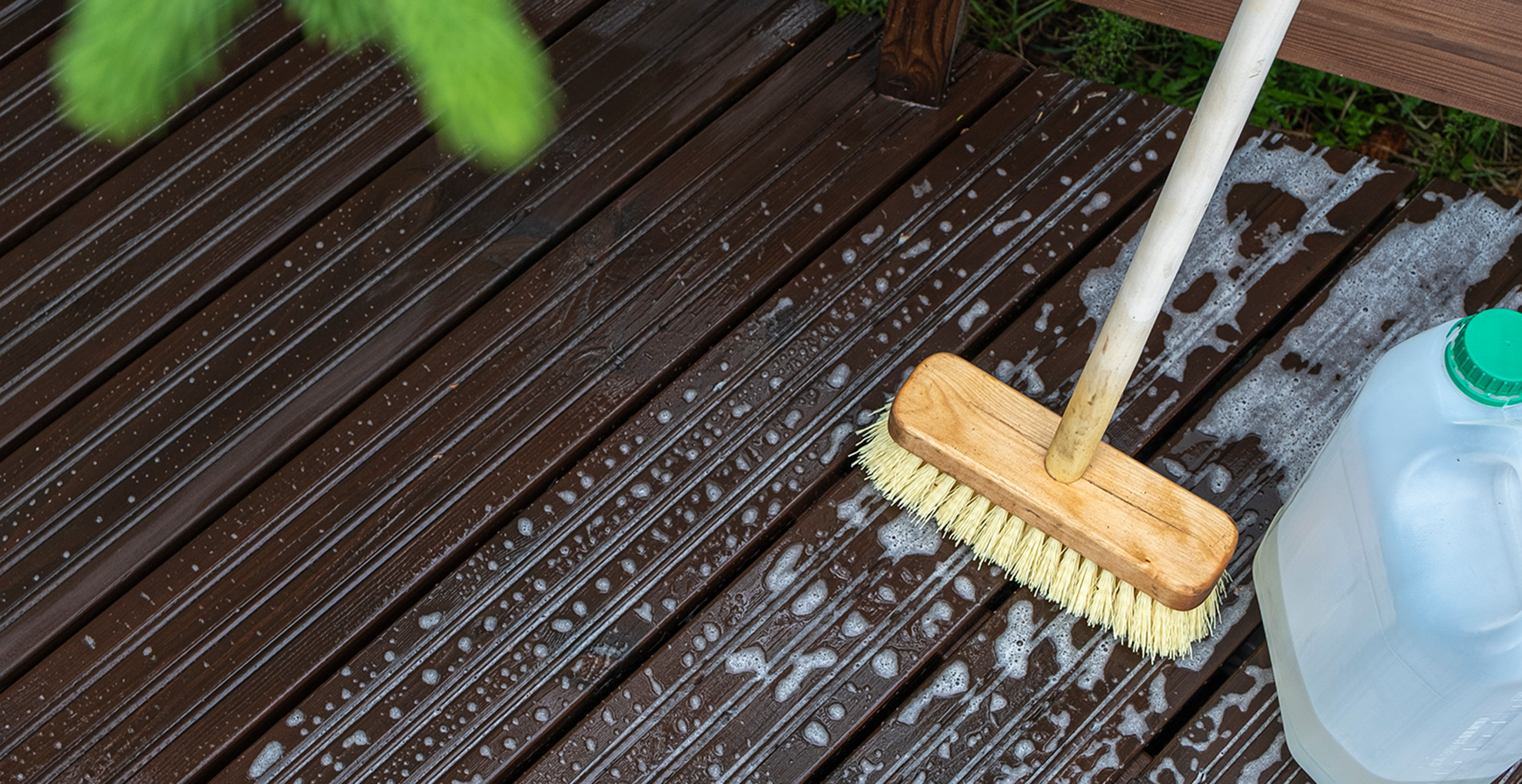
For this step, you can get a specially made wooden deck cleaner from your local garden centre or hardware store. All you need to do is mix the cleaning solution according to the manufacturer's instructions. Make sure to find the appropriate choice; you don't want to just start cleaning with white vinegar and damage your wood.
Roxil Garden expert Jonathan says, "Opt for a biocidal cleaner, which is an effective non-destructive alternative and actually helps minimise regrowth."
Or, if you haven't had the chance to go out and buy an over-the-counter cleaner or would prefer to make one yourself, you can do so with ease. Ivo suggests, "You can create a homemade solution by combining 1 gallon of warm water with 1 cup of oxygen bleach (not chlorine bleach). This mixture is highly effective." If you are going to make one yourself, remember to wear gloves.
The best time to clean your deck is on a cloudy day so that the cleaner has a chance to sink into the wood and doesn't just evaporate.
Use a paint roller or a stiff-bristled brush broom to work the cleaner into the wood and rinse it afterwards. Remember to allow your cleaner to dry, so you don't end up with mould or mildew on your deck.
4. Let the solution sit
Once you've made sure that the entire decking is covered in the cleaning solution, leave it to sit for at least 10-15 minutes to work its magic and break down dirt, grime, and algae.
For a deeper clean, leave the solution to sit for even longer, but for no more than 24 hours, and only if the weather is set to be dry for that time.
Roxil Garden expert Jonathan says, "You can see it’s working when the algae-covered surfaces start to go black or brown – this is a sign that it’s dying."
5. Rinse and remove excess water
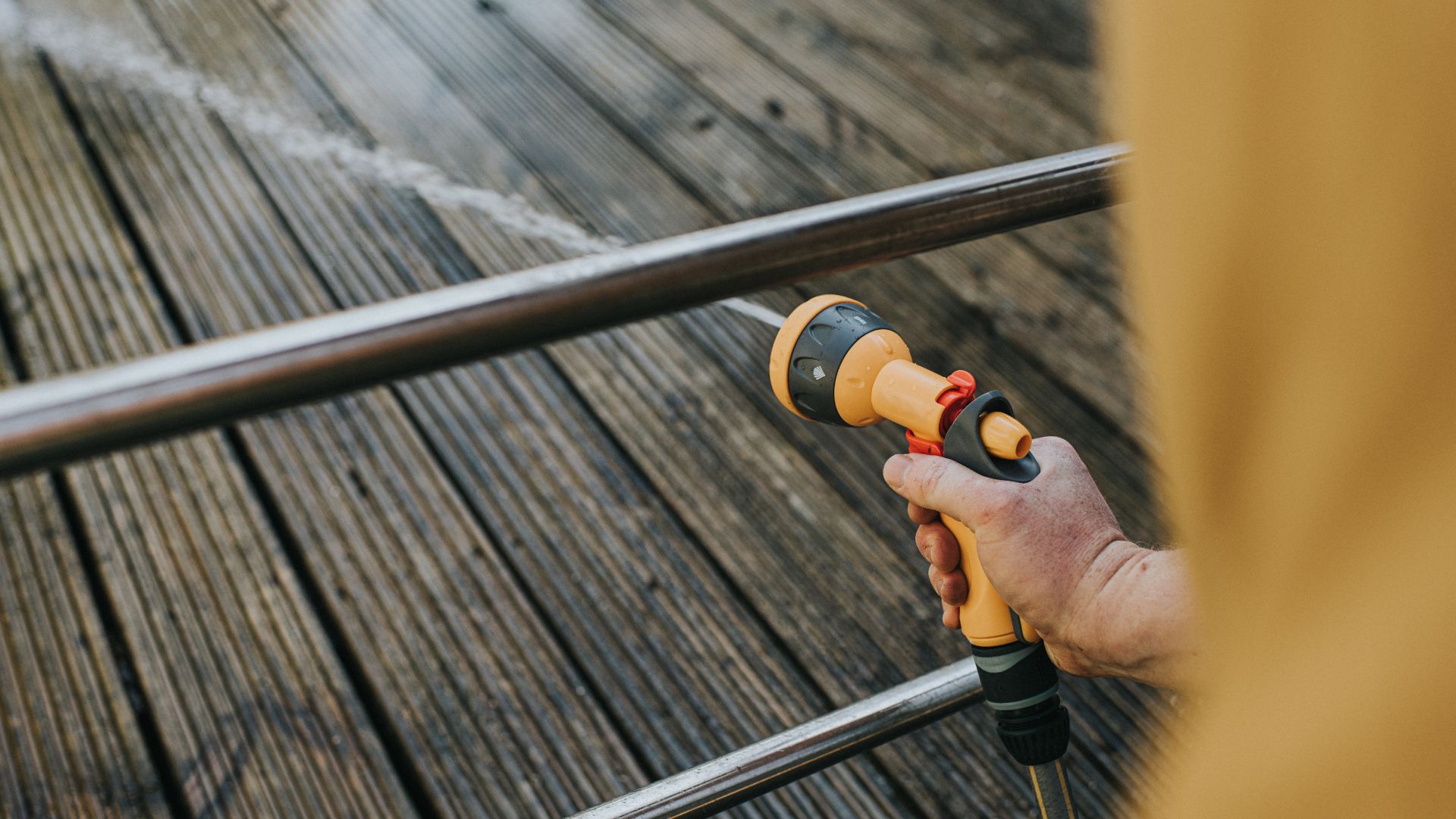
Without using a pressure washer, the best way to rinse the deck is to use a garden hose to ensure maximum coverage. Ivo says, "Rinse the deck thoroughly, ensuring all the cleaning solution and loosened dirt are removed." Use your broom again at this stage to remove excess water from the surface area.
"Give your wooden decking ample time to dry completely before returning any furniture or items to the area. This may take anywhere from 24 to 48 hours, depending on the weather conditions."
Why not start cleaning your outdoor cushions to remove any dirt or mould while you wait?
Optional: Treat your decking
Once your decking is completely dry and clean, you might want to seal or stain it. Though this is completely optional, it will help keep your decking looking fresh and is highly recommended by experts.
"If your wooden decking needs additional protection or a fresh look, consider applying a high-quality wood sealer or stain," suggests Ivo. "Always follow the manufacturer's instructions for the best results."
Generally speaking, stains are a bit more expensive than generic sealants and take longer to dry, so if you can get away with using a plain sealant, you should. It depends on where your deck is in your house. If it is in direct sunlight, you will want to use a stain to protect your deck from the direct sun; if your deck gets plenty of shade from surrounding trees, then sealant will work just fine.
Jonathan advises using a weatherproofing cream to avoid dirt from building up every year. "The best way to stop all these issues coming back is to stop moisture ingress by using a suitable wood weatherproofing cream to treat the decking," he says.
"This creates a waterproof barrier without changing the texture or significantly changing the colour of the wood. This will reduce warping and prevent the occurrence of rot. And by keeping the surface of the wood dry, the amount of superficial mould and algae growth will reduce significantly."
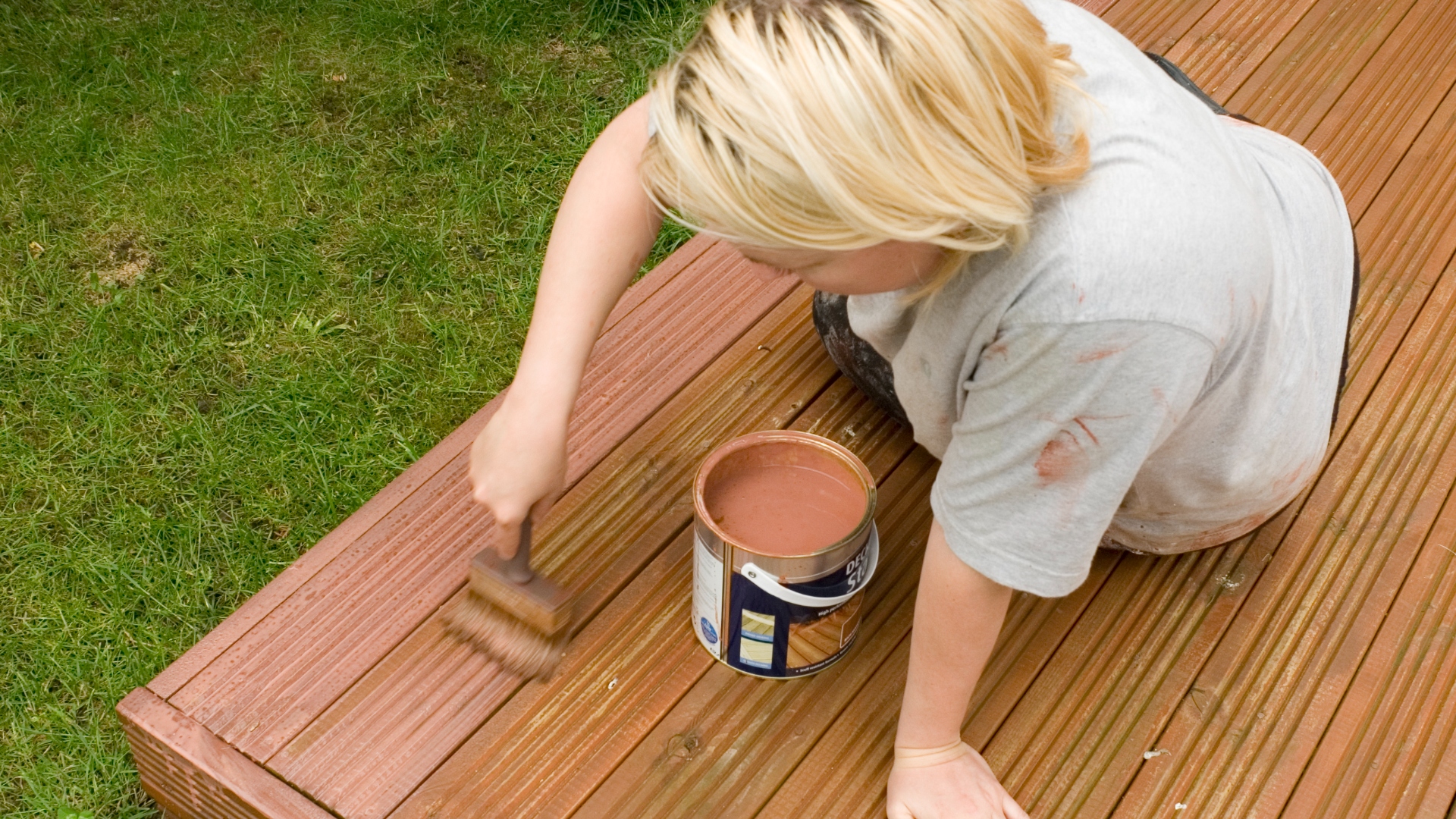
How to clean decking with a pressure washer

One method of cleaning your wooden deck is to use a pressure washer. The beauty of using a pressure washer is that you don't need to get on your hands and knees to scrub the decking - the pressure washer does the hard work for you.
If you are using a pressure washer, set it up by attaching a wide-angle nozzle, 25-40 degrees is ideal, and apply the cleaning solution using the pressure washer's detergent attachment. You need to maintain a low-pressure setting to prevent damaging the wood.
Decor Home Ideas' Ivo says, "Using a pressure washer with a wide-angle nozzle and maintaining a low-pressure setting can help you avoid damaging the wood. Be sure to hold the nozzle at least 12 inches away from the deck's surface and spray in the direction of the wood grain."
FAQs
Is it ok to pressure wash decking?
It's OK to use a pressure washer to clean your wooden decking, you just have to be careful and make sure it's on a low setting.
"A common method for cleaning decking is to use a pressure washer," says Roxil's garden expert, Jonathan Kirby. "They can produce impressive results, but frequent use can cause long-term problems."
"The high-powered spray can damage the fibres of the wooden boards and cause splintering. This makes the rate of moisture ingress worse, which not only increases the likelihood of mould and algae but also of warping and rot – and this is a death sentence for your decking if left untreated."
So, make sure you keep your pressure washing on a low setting and a safe distance away from the wood, and you're good to go.
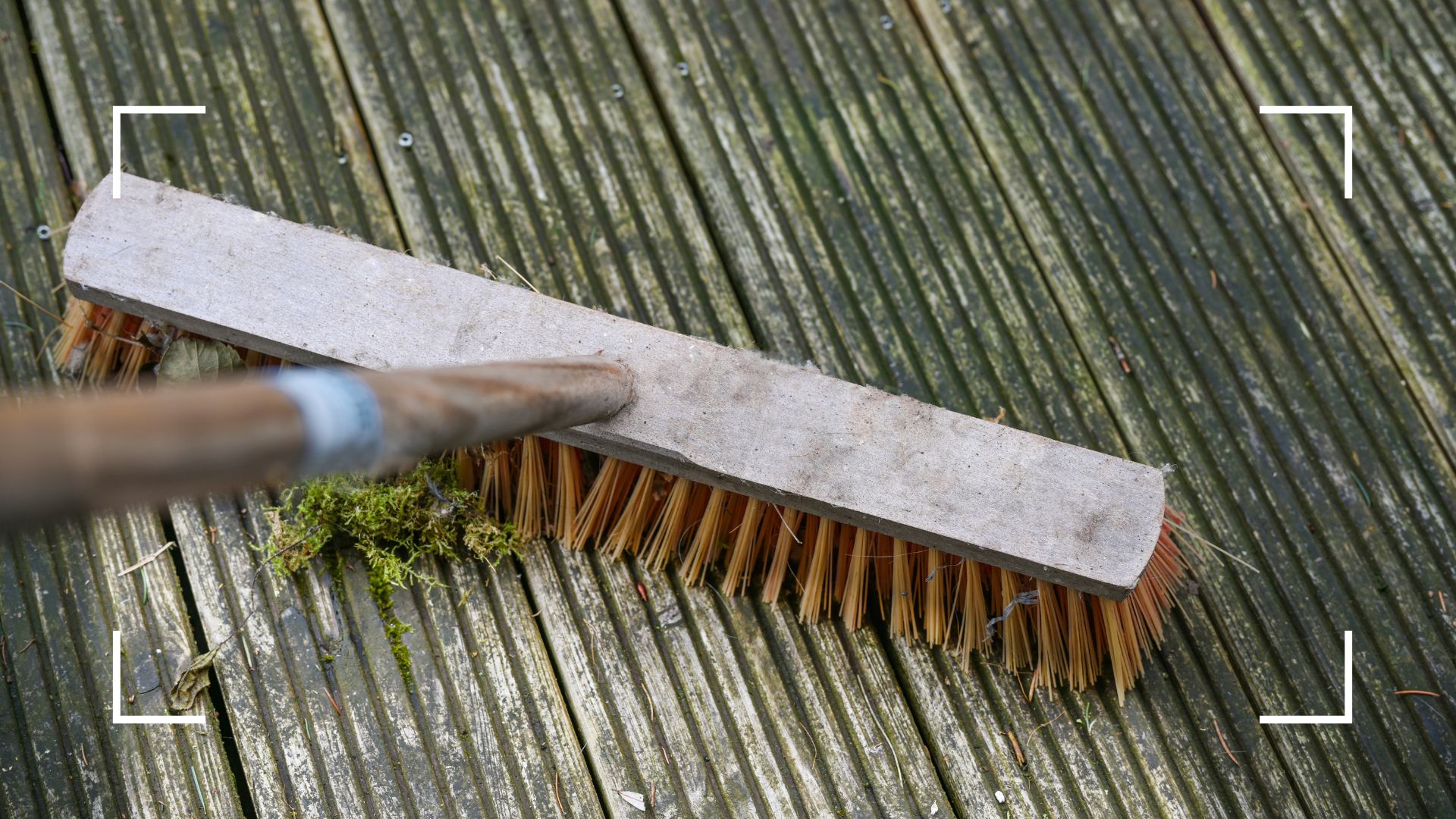
How do you clean a deck without a pressure washer?
When it comes to cleaning your wooden decking without a pressure washer, the steps are actually very similar – only you do the task by hand using a hose and a scrubbing brush.
Instead of using a pressure washer to pre-wash the deck, you use a standard garden hose, and rather than apply the cleaning solution using a pressure washer, you use a soft-bristled brush instead to scrub the solution over the surface gently, making sure you cover the entire decking.
For an extra deep clean, use a hard-bristle brush to remove stubborn dirt. Jonathan says, "For best results, once the cleaning product has worked its magic, we’d recommend using a wet stiff brush to loosen the mould, algae, and dirt. This is particularly helpful on any more challenging patches."
Then, instead of using your pressure washer to rinse off the solution, simply use a garden hose instead. Let the decking dry, as explained above, and you're done.
How do I get green algae off my wood decking?
Using the standard cleaning methods stated above should remove algae from your decking, but Leo has an expert cleaning hack to help clean up any stubborn areas.
He suggests, "Using a non-toxic cleaner designed for wooden surfaces works wonders. Apply the cleaner according to the instructions, scrub gently with a soft-bristled brush, and rinse it off with water. Regular cleaning and maintenance can help prevent algae from coming back."
Ivo adds, "To remove green algae from your wood deck, you can use a cleaning solution that contains oxygen bleach, which is effective against algae and mildew. Apply the solution to the affected area, let it sit for 10-15 minutes, and then scrub with a stiff-bristled brush. Rinse the area thoroughly with a garden hose or pressure washer to remove any residue."

Will bleach damage a wooden deck?
Bleach is something you need to be very careful with when cleaning your wooden decking, as it can damage the wood, which is why experts suggest using an oxygen bleach instead of a chlorine one.
Decor Home Ideas' Ivo explains, "Chlorine bleach can damage a wooden deck by causing the wood to become discoloured, dried out, and brittle. It can also harm the surrounding plants and grass. Instead, use oxygen bleach, which is a safer and eco-friendly alternative that won't damage the wood or harm the environment. Remember to dilute the oxygen bleach with water before applying it to your deck."
Roxil Garden expert Jonathan agrees, adding, "Similar to pressure washing in the incorrect way, using bleach or bleach-based cleaning products can damage your decking. The bleach changes the cellular structure of the wood, which weakens it and changes its colour. Bleach can also break down some finishes and coatings, which then leave the decking susceptible to water and other chemical damage."
So when it comes to cleaning your decking, it's important to stick to cleaning solutions that are specially made for wooden decking or use your homemade solution of oxygen bleach and water.
Can I use washing-up liquid to clean my decking?
Washing-up liquid is one of the most unexpected hero products when it comes to sorting your garden out and giving it a good clean.
"Yes, you can use washing-up liquid to clean your decking, and it's a good option for routine maintenance or light cleaning tasks. Dish soap is gentle on wood and composite decking, making it a safe choice for surfaces that can be damaged by harsher chemicals," explains Ionel Giuran, landscaping and lawn care expert at Fantastic Gardeners.
He also adds that it's particularly effective at removing everyday grime, pollen, food spills and bird droppings. All whilst being gentle and non-harmful to any surrounding plants or grass, once you've rinsed it.

Ionel has over 8 years of dedicated service at Fantastic Gardeners as an experienced lawn care expert, with additional knowledge and skills in tree surgery, landscaping and gardening. His passion for nurturing green spaces has driven him to excel in various areas of outdoor maintenance, earning him a reputation for meticulous attention to detail at Fantastic Gardeners' lawn care department.
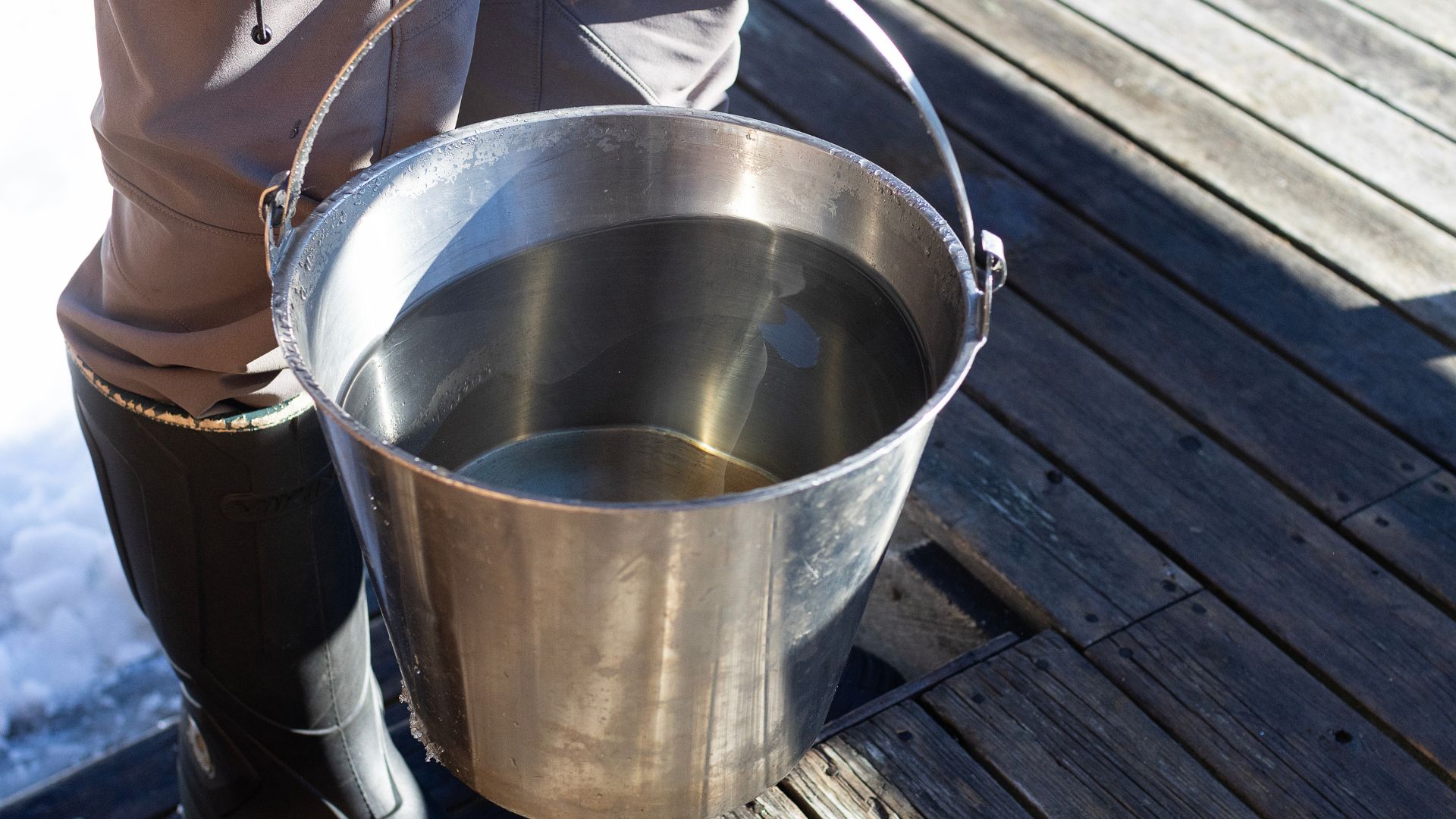
What is the best homemade deck cleaner?
It's no secret that cleaning with vinegar and other natural cleaning agents is the best way to tackle most jobs inside and outside of your home. Making your own cleaning solutions will ensure there's no hidden nasty chemicals, and you can tailor them to the type of decking you have.
"What the best homemade deck cleaner is will depend on the condition of your deck and what you're trying to tackle, but for an all-purpose, safe, and effective cleaner, a solution of white vinegar, baking soda, and warm water will work exceptionally well," recommends Ionel.
He continues, "It’s non-toxic, biodegradable, and safe for use around plants, pets, and most decking materials, including wood and composite. This mix helps remove dirt, mildew, and algae without damaging the deck surface."
Now you've got your decking sparkling clean why not tackle cleaning your pizza oven, that way your guests won't only find your decking impressive but your pizza-making skills too!
Robyn is a celebrity and entertainment journalist and editor with over eight years experience in the industry. As well as contributing regular to woman&home, she also often writes for Woman, Woman's Own, Woman's Weekly and The Sun.
- Emily SmithDigital lifestyle writer